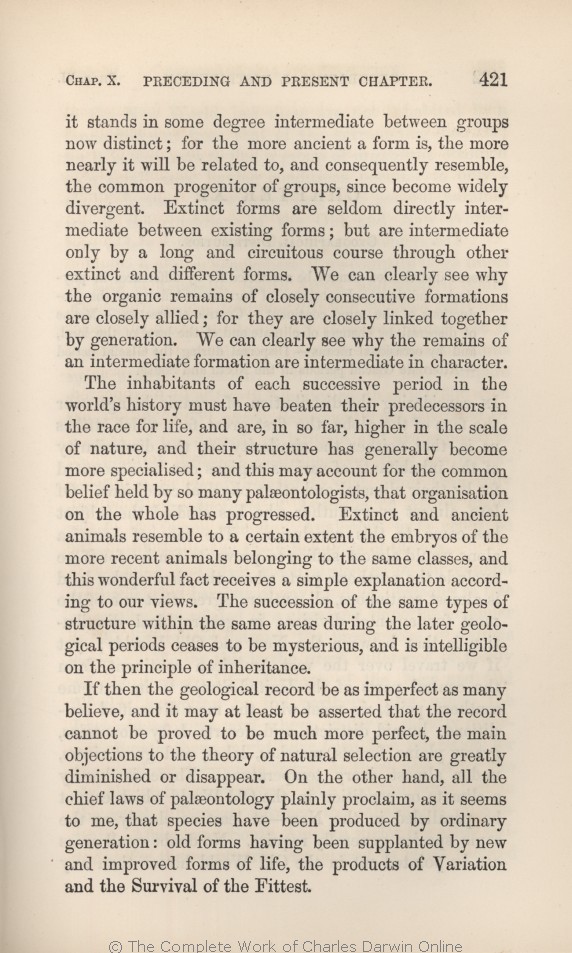..| ..... 1869 1872 | | apparently, 1859 1860 1861 1866 |
| stands 1869 1872 | | displays characters 1859 1860 1861 1866 |
| become 1861 1866 1869 1872 | | be- come 1859 1860 |
| other 1869 1872 | | many 1859 1860 1861 1866 |
| extinct and 1869 1872 |
| extinct and very 1859 1860 |
| other extinct and 1861 1866 |
| ..... 1869 1872 | | more 1859 1860 1861 1866 |
| allied; 1869 1872 | | allied 1859 1860 1861 1866 |
| OMIT 1869 1872 |
| to each other, than are those of remote formations; 1859 1860 1861 1866 |
| they 1869 1872 | | the 1859 1860 1861 1866 |
| ..... 1869 1872 | | forms 1859 1860 1861 1866 |
| ..... 1869 1872 | | more 1859 1860 1861 1866 |
| generation. 1869 1872 | | generation: 1859 1860 1861 1866 |
| ..... 1869 1872 | | we 1859 1860 1861 1866 |
| ..... 1869 1872 | | can 1859 1860 1861 1866 |
| ..... 1869 1872 | | clearly 1859 1860 1861 1866 |
| ..... 1869 1872 | | see 1859 1860 1861 1866 |
| ..... 1869 1872 | | why 1859 1860 1861 1866 |
| ..... 1869 1872 | | the 1859 1860 1861 1866 |
| ..... 1869 1872 | | remains 1859 1860 1861 1866 |
| ..... 1869 1872 | | of 1859 1860 1861 1866 |
| ..... 1869 1872 | | an 1859 1860 1861 1866 |
| ..... 1869 1872 | | intermediate 1859 1860 1861 1866 |
| ..... 1869 1872 | | formation 1859 1860 1861 1866 |
| ..... 1869 1872 | | are 1859 1860 1861 1866 |
| ..... 1869 1872 | | intermediate 1859 1860 1861 1866 |
| ..... 1869 1872 | | in 1859 1860 1861 1866 |
| ..... 1869 1872 | | character. 1859 1860 1861 1866 |
|
|
The inhabitants of
each successive period in the worlds | each successive period in the worlds 1869 |
| each successive period in the world's 1859 1860 1861 1866 |
| the world at each successive period in its 1872 |
| must have 1861 1866 1869 | | have 1859 1860 1872 |
| scale 1859 1860 1861 1866 1869 | | scale, 1872 |
| of nature, 1861 1866 1869 |
| of nature; 1859 1860 |
| and their structure has generally become more specialised; 1872 |
| their structure has generally become more specialised; and this 1869 |
| this 1859 1860 1872 |
| their structure will generally have become more specialised; and this 1861 1866 |
| the common belief held by so 1869 1872 |
| that vague yet ill-defined sentiment, felt by 1859 |
| that vague yet illdefined sentiment, felt by 1860 |
| that ill-defined yet common sentiment, felt by 1861 1866 |
| 2 blocks not present in 1869 1872; present in 1859 1860 1861 1866 | | If it should hereafter be proved that ancient animals resemble to a certain extent the embryos of more recent animals of the same class, the fact will be intelligible.
The succession of the same types of structure within the same areas during the later geological periods ceases to be mysterious, and is simply explained by inheritance.
|
|
|
If then the geological record be as imperfect as
many | many 1869 1872 | | I 1859 1860 1861 1866 |
| believe, 1869 1872 | | believe 1859 1860 1861 1866 |
| OMIT 1869 1872 |
| it to be, 1859 1860 1861 1866 |
| the products 1869 1872 |
| produced by the laws 1859 1860 1861 1866 |
| Variation 1869 1872 | | variation 1859 1860 1861 1866 |
| and the Survival of the Fittest. 1869 1872 |
| still acting round us, and preserved by Natural Selection. 1859 1860 1861 1866 |
|









